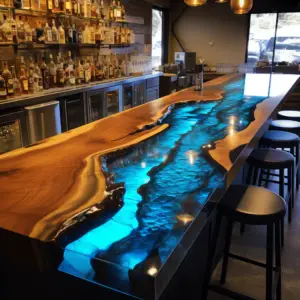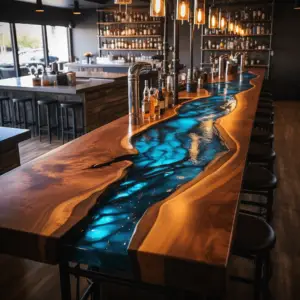Several variables may drive you to choose a classic bar top material like wood, marble, plastic, granite, or laminate.
A commercial bar top wears out quickly. It will be loaded, spilled, dirty, heated, abrasive, and frequently cleaned, wiped, and scrubbed.
All these activities will accelerate deterioration, especially of the top surface, so you’ll need to replace or update your establishment’s face to maintain it looking excellent.
In an entertainment establishment, your bartop must be attractive, inviting, and engaging. Bar tops are important club features that can attract and maintain customers.
A wide range of decor and design technologies has made this possible and led to an explosion of color, panache, beauty, and sophisticated motifs in entertainment venues.
Epoxy and polyurethane are two of the most adaptable materials for bar tops and businesses.
Table of Contents
Epoxy vs Polyurethane bar top: Which is Better?

Both of these are resins or derivatives of resin mixtures so there are many kinds of each to choose from.
They are thermosets which basically means that they come in viscous liquid form and upon application, they will set and harden in an irreversible curing process forming a solid surface, block, or coating.
The differences are subtle but they matter especially in the long run. The following are some of the considerations to take into account when choosing between the two for your bar top.
Epoxy vs Polyurethane bar top: Durability
A durable bar top needs to be a very hard surface. Both epoxy and polyurethane blocks or coatings are incredibly hard and therefore very durable.
Both end materials will be very hard depending on the mixture’s hardness, but polyurethane allows you to design the particular hardness you want more easily than epoxy.
Epoxy can deteriorate over time when exposed to alkaline and acidic chemicals such spirits, rums, gins, whiskeys, and commercial cleaning products. These last longer with polyurethane.
While both last years, polyurethane will outlast epoxy because UV radiation turns epoxy yellow.
Epoxy vs Polyurethane bar top: Heat and moisture resistance
In a bar setting the exposure of the bar top to extreme heat and moisture does not rise to the levels needed to make significant damage. Both epoxy and polyurethane will withstand the quantities of heat and moisture exposure very well.
Epoxy vs Polyurethane bar top: Flexibility
When working with these products, especially as a DIY project, you should know that epoxy hardens as soon as you formulate your combination and hardens quickly, so you will have little time to design for application and design.
Polyurethane hardens quickly after being liquid, giving you the ability to construct a design motif.
The trick with polyurethane is knowing when it will set because you can only mold it using power equipment. Because of this, polyurethane is easier to form than epoxy. More skill is needed to mould epoxy than polyurethane.
Epoxy vs Polyurethane bar top: Versatility
Both these thermosets are so versatile that you can do virtually anything as you design and fashion your bar top.
These materials have formed some wonderful bar tops, so you can make the full block or just coat a marble or hardwood bar top.
The resins can be cast to make a sea monster, abstract, geometric, or favorite vehicle bar top.
Since they work with any pigment, you may make a color collage. Modern bars are beautiful.
Epoxy vs Polyurethane bar top: Adhesion

If you are working with another material as well as one of these two thermosets, you should pay particular attention to how they will adhere to the other substrate such as wood. Epoxy has superior adhesion compared to polyurethane.
Epoxy is superior for fitting a resin block between two wooden blocks to form a motif. Hard and totally attaches to a substrate, it cannot be removed without damaging it.
Polyurethane must be treated before joining, making it tough to shape into the image shown.
The longer drying period may force you to design the block before joining, which is not suitable for coloured polyurethane.
However, using these materials in DIY projects presents numerous obstacles. Professional artisans can create the most unusual bar top patterns you can imagine, and they will flawlessly complete your order.
Epoxy vs Polyurethane bar top: Cost
Polyurethane costs more than epoxy, but its durability offsets the difference. Polyurethane does not rot or yellow, and if your composite is durable, it can last 20–30 years, twice as long as epoxy.
